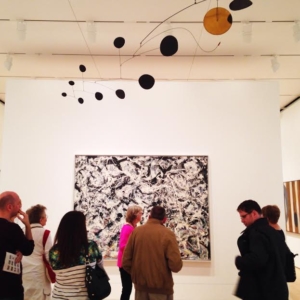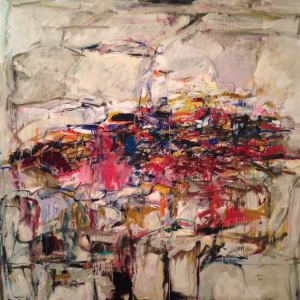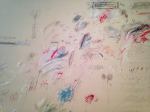
Painting by Jackson Pollack; mobile by Alexander Calder
“Paint as you like and die happy.” — Henry Miller
There is a very difficult journey that some brave artists take: It’s the journey of unlearning. To take all you have learned about the rules of perspective, proportion, light and shadow … and let those rules guide you into a place of breaking them.

By Joan Mitchell
Breaking the rules in art successfully is not about “anything goes”; it’s a deep and personal journey. It’s about going beyond the rules into a “no man’s land” where you are very much working alone, from instinct, and completely dependent on your imagination.
Rendering realism is a discipline that I have great respect for, but a brilliant abstractionist can bring me to my knees in awe. That requires something different: imagination, flow, disidentifying from the outcome and surrendering to the present. It is why so many artists move into abstraction in later years and find the greatest joy there.
I am thinking about all of this as a result of having visited the Modern Wing of the Art Institute of Chicago. I have yet to stand in one of my favorite galleries while gazing upon the great works of Cy Twombly, Joan Mitchell, Jackson Pollack and many other of the Abstract Expressionist works without overhearing comments like “I could do that,” “My kid could do that,” and other versions of this nonsense.
I realize that this comes from a place of not understanding, but the truth is, no, you can’t do that. That is why you don’t have paintings hanging in museums and they do.

By Cy Twombly
Upon hearing such statements, I have an immediate desire to hand the speaker a canvas and paint, along with an invitation to try — with helping them grow in their own appreciation as my only intention.
You do not have to like it — everyone, after all, has his or her own preferences when it comes to visual appeal — but it’s useful to have an understanding: It is not a lack of knowing the rules that takes an artist to abstraction, but a moving beyond them. It’s like the old saying: “You have to learn the rules to break them.”
Understand that most of your favorite artists’ work likely moved into more abstraction with age. It’s a joyful place for an artist to paint — not by rendering reality, but from their heart, their own creative filter, which takes years to truly know and trust.
Cheers to breaking the rules and finding happiness outside the box!
Details of Joan Mitchell’s work:
Details of Cy Twombly’s work:
Pieces by Gerhart Richter — a great example of his early work towards realism, and his later abstract works:








Thanks so much for this posting, Stephanie. I’m not an artist. I do lead an organization that is documenting all of Chicago’s public art; and I am a docent at Chicago Architecture Foundation, where I developed and lead two tours named “Hidden (Mostly Outdoor) Art” and “Hidden (Mostly Indoor) Art”. I have often in my life had people look at works by artists like John Henry and say, as you suggested, “I could have done that” or “Anyone could have done that.” I always respond, “Well, did you?” Or, ” ‘Anyone’ wasn’t the artist. It was John Henry, and he did this with intention and great skill – both things that just about all ‘Anyones’ lack.”
I, too, love the various abstractionists and have stood in the Modern Wing and been entranced by their work. What’s amazing to me is that we are 50 to 120 years beyond the heydays of many of the artists shown in the Modern Wing, but people still pine for the art of the monumental sculptors and of those they think were “realists.” The fun for me is every now and again to point at a couple of things in a painting or a sculpture and to try to peel the nictitating membrane from covered eyes. Sometimes it actually works.
What a very thoughtful comment. Thank you for sharing and for giving art tours. I so firmly believe anyone’s life would be enriched by a knowledge of art!